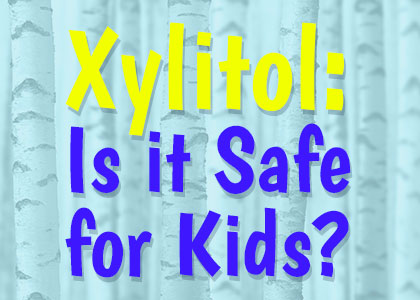

Xylitol is a naturally-occurring substance found in the birch tree and in many fruits and vegetables. Its chemical structure resembles a cross between a sugar and an alcohol—but it is neither. Xylitol is used as an FDA-approved artificial sweetener that can also assist in the prevention of tooth decay, so Mullica Hill dentists Drs. Bo and Christina Levitsky would like to share some information about xylitol’s safety for kids.
How is Xylitol Used?
Because bacteria in the mouth cannot use xylitol as an energy source, oral care products like toothpaste and mouthwash often contain xylitol to help alleviate dry mouth symptoms and prevent tooth decay. When extracted from birch wood, xylitol can be used as an active ingredient in other medicines as well. Its capability to eliminate or reduce the effects of bad bacteria extends to those that cause ear infections in young children.
How Does Xylitol Work?
Xylitol tastes sweet like sugar but contains fewer calories and is absorbed more slowly by the body, reducing the likelihood of dramatic blood sugar spikes. These characteristics make xylitol an ideal sugar substitute for diabetics. Unlike other artificial sweeteners and sucrose (actual sugar), xylitol reduces the bacteria that cause tooth decay in the saliva.
Is Xylitol Safe for Children?
The unaltered natural xylitol present in fruit and vegetables should be safe for kids, barring allergies or a major produce binge. Cavity prevention medicines containing xylitol that are used in pediatric dentistry typically range from 7 to 20 grams per day (divided into three to five doses). More than 20 total grams of xylitol per day is not recommended for children.
Like other artificial sweeteners, exceeding the recommended intake of xylitol can cause pronounced physical discomfort, including diarrhea and intestinal gas. Because children’s medicines containing xylitol may taste as good as regular candy, parents need to be careful that kids don’t eat more than the recommended amount!
WebMD® warns that not enough is known about the potential risks of xylitol intake during pregnancy and breastfeeding, so pregnant or nursing mothers should avoid using xylitol to err on the side of caution.
Non-Medical Products that May Contain Xylitol
If you buy sugar-free items a lot, it’s good to be aware of which items in your kitchen, fridge, or pantry may contain xylitol:
- Packaged goods (ice cream, yogurt, gelatin, pudding)
- Packaged mixes (pudding, gelatin, baking mixes)
- Flavored bottled water
- Powdered drink mixes
- Candies, gum and mints (keep an eye on your purse!)
- Jams and jellies
- Syrup and honey
- Protein bars and powders
- Peanut and other nut butters
- Vitamins and supplements (especially gummies)
- Liquid shots for energy, sleep, etc.
Keep the Xylitol Away from Your Pets
Xylitol in any amount can be toxic to dogs and cats. If you have reason to believe your pet has swallowed anything containing xylitol—especially if it also contains chocolate—take them to the vet immediately. Xylitol in the proper doses can be very useful and safe to promote better oral health for both adults and kids. If you have any questions about xylitol, its uses, and its safety, contact us at Mullica Hill Family Dental today!
The content of this blog is not intended to be a substitute for professional medical advice, diagnosis, or treatment. Always seek the advice of qualified health providers with questions you may have regarding medical conditions.
Sources
https://www.webmd.com/vitamins-and-supplements/xylitol-uses-and-risks#1
https://www.webmd.com/vitamins-supplements/ingredientmono-996-xylitol.aspx?activeingredientid=996
https://iheartdogs.com/11-surprising-products-that-contain-xylitol/